Cohen, Peter, &
Arjan Sas (1992), Loss of control over cocaine: Rule or exception?
Paper presented at the American Society of Criminology, New Orleans 3-7
November, 1992. Amsterdam, CEDRO Centrum voor Drugsonderzoek, Universiteit
van Amsterdam.
© Copyright 1992 Peter Cohen &
Arjan Sas. All rights reserved.
Loss of control over cocaine
Rule or exception?
Peter Cohen & Arjan Sas
In this contribution we will examine data on 268 experienced cocaine users in order to try to answer the question: is loss of control in cocaine users exception or rule? Before we will try to shed some light on this question we will be forced to enter into some matters of definition and perspective. Because the concept "control" in the use of illicit drugs is not well known or often applied, also its definition is not well established. The concept of "loss of control" seems to be more adapted to current perspectives on illicit drug use, but even here the precise meaning of the concept is not established. So, first we need conceptual definitions of control and of loss of control in order to answer the question we set out with. Second, we not only need definitions on the conceptual level. If we want to study this question empirically, we also need quantifiable measures in an operational sense.
Let us begin with conceptual problems. We will use three authors briefly to indicate what types of thinking we consider useful for tackling some of the questions. The first author to give some help on this issue is Michael Bozarth, an American psychologist working in the field of the psycho-biology of drugs. Bozarth elaborates the concept of addiction, which he sees as an extreme case of drug use. According to Bozarth drug addiction refers to
"a situation (...) where the drug seems to dominate the organism's
motivational hierarchy"
(Bozarth, 1990, p.113).
The term motivation is essential in Bozarth's approach.
"At some point there is a shift in control from intrapersonal/sociological to pharmacological factors in drug taking behaviour. This is concomitant with a marked increase in the motivational strength of the drug...." (Bozarth, 1990, p.115).
Once addicted an organism "becomes increasingly under the control of basic pharmacological mechanisms" (Bozarth, 1990, 115).
Once these pharmacological mechanisms set in an individual will experience the addiction as out of control. These mechanisms will also play an essential role in "drug induced alterations in desires and their fundamental role in addiction" (Bozarth, 1990, 124) Motivational strength of drug taking behaviour has become very high and seems to be unaffected by other motivations.
Addiction, according to Bozarth, is thus "primarily under the control of pharmacological effects on brain motivation and reward mechanisms.." (Bozarth, 1990, 132). Although it is nowhere stated explicitly, we may assume from all of the contexts in Bozarth's article that once pharmacological factors "take over", per definition others aspects of behavioural control are incapacitated.
In the following illustration, made by Bozarth, we will show you how this way of reasoning seems to be very complete.
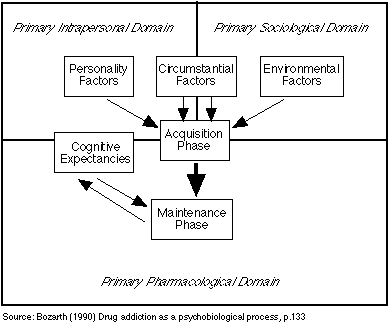
It reserves roles for the main scientific domains, it gives a dynamic view on drug use, and what is most important, it seems to give room for non addicted use which is not governed by pharmacological mechanisms that, in Bozarth's view, take away an organisms control over drug use use once addiction has set in. In other words, an organism once addicted has to adapt to the extreme motivational strength drug seeking behaviour has acquired. The organism is the victim of his brain directed motivations. Addiction in this view equals loss of control (of ones volitional forces to brain chemical process). We do not share this view on addiction[1], but for our present contribution this disagreement does not have to be further pursued.
How do we recognize such cases of loss of control? Here Bozarth gives operational indicators. Because motivational strength is so important in Bozarth's reasoning, he uses this concept to identify indicators of operational definitions of addiction, or loss of control. The aspects that are open for quantitative measuring of motivational strength are response latency, response frequency and response vigour. In the "loss of control" scale we will present to you later, you will find some of our own operational applications of these three indicators.
Of course, Bozarths approach opens very many questions. But the most important question in the context of this paper is: how often does "loss of control" occur in a set of cocaine users? Bozarth does not answer this question. He merely provides us with a theoretical or conceptual tool that might serve to do the necessary counting.
Before we will try to look for answers with other authors we will briefly mention a sampling problem here that often leads to what Patricia and Jacob Cohen recognised as "the clinicians illusion" (Cohen and Cohen 1984). "It has become a familiar convenience to accept persons with some established diagnosis who attend some clinical service as representing a larger population of persons with the disorder investigated" (Cohen and Cohen, 1984, 1181). If one wants to count cases of "loss of control" according to any one system of measurement, where does one look for countable elements? When one looks in treatment centres one becomes an immediate victim of Cohen's Clinicians Illusion[2]. Loss of control in all cocaine users that are in treatment may be accepted as fact (although we do not) but cocaine use outside treatment centres is not described. This means that if in treatment centres for cocaine users 100% of the persons may show one or more diagnostic elements of loss of control, we still do not know how large their proportion is of all cocaine users, included the ones that are not in treatment and that will for a large part never even see treatment.
If one looks only inside treatment centres one may miss a lot of assumed loss of control behaviour with resulting under estimation of the proportion of cocaine users that "loose control". To a large extent this problem can be dismissed by allowing for an operational definition of loss of control that does not necessarily mean "being in treatment". One then can include all available diagnostic tools that would also screen persons that should be in treatment (according to the "wide" operational definition) although they are not. But, if one looks outside treatment contexts, does one look for such heavy users one may expect a lot of diagnostic indicators to be positive? This is the sampling problem we are wrestling with. Depending on where and for whom one looks, one will find a changing proportion of cocaine users that score positive on some loss of control diagnostic measure.
Zinberg study of controlled use contains some interesting perspectives on control and loss of control. For him controlled use is the application of socially established rules to the use of drugs. These rules have been internalised. For Zinberg the application of accepted social conventions to the use of drugs is of paramount importance. Once drug takers "are.. contravening all standards of acceptable behaviour [they] must be classified as drug abusers" (Zinberg, 1984, p.42) Drug abuse and compulsive drug use are used simultaneously by Zinberg. And we take the freedom to equate Zinberg's concept of compulsive use with "loss of control" for the sake of brevity and simplicity.
Although interesting, Zinberg's criterion of "acceptable behaviour" makes it difficult to diagnose drug use compulsion. When does behaviour become unacceptable? Apparently there is a large grey area, and exactly this makes it difficult for Zinberg to develop operational criteria for compulsive use. If one starts to break social conventions because of drug use, does this mean one has "lost control" to a drug use compulsion, or that one has intentionally shifted rule system? Although Zinberg's criteria for being included in his study as a controlled or as a compulsive drug user all apply frequency/quantity of use as a central operationalisation, Zinberg admits that later "qualitative" adjustments had to be invented to decide on which side of the line between compulsive and controlled use a certain user had to be located. But, as you will see later, some of the items in our "loss of control scale" could be recognized as severe breaks with conventional rule systems. Our frequency of use measures and level of use measures are related both to Zinberg's thinking and to Bozarth's, although the two are miles apart in as far as conceptual tools are concerned.
The third author we would like to use for this exercise is actually three authors: Waldorf, Reinarman and Murphy. They recently wrote the study "Cocaine changes" in which they report their findings after investigating 267 heavy users of cocaine. Their study could actually be a rich source for the search for indicators or operational definitions of loss of control exactly because of their ample use of qualitative methods in their study.
Controlled use of cocaine is defined by them as "regularly ingestion of cocaine without escalation to abuse or addiction, and without disruption of daily social functioning." (Waldorf et al 1991, p.140). There is a problem in this definition: it does not tell us how to look for a lack of abuse or addiction in an operational way, nor does it give a clear lead as how to look for disruption of daily functioning. We might assume however that a lead can be found in the emphasis in the Waldorf et al study on what they see as an essential part of cocaine user's ability to maintain control:
"a commitment to their everyday lives gave them a stake in normalcy and bonded them to the conventional world" (Waldorf et al 1991, p.220).
They use the term conventional world, like Zinberg his "acceptable behaviour".
Another vehicle of control according to Waldorf et al is the changing
high of cocaine after intensive use. One simply has to limit ones use
in order not to loose the ability to enjoy the cocaine high. Limitation
of use might be found in cutting down, but also in regular periods of
abstinence.
Another set of indicators for operational definitions of controlled cocaine
use could be found in the recipes Waldorf et al wrote for minimizing the
likelihood of getting into trouble with cocaine (Waldorf et al 1991, p.278).
Controlled use is best guaranteed when one is
- not using daily
- has rules for when and where to use and how much
- no regular supply of cocaine in ones house
- not selling cocaine
- not using cocaine to "solve" problems or to compensate for shortcomings
- subordinating one's use to the demands of daily life.
Some of these points will be found in the loss of control scale we made. The problem is, that our data do only partly support the Waldorf et al recipe. We found periods of daily use to be perfectly compatible with the daily life styles of our respondents that could not or hardly be distinguished from what is considered "normal" in Amsterdam.
And why people should not use cocaine to compensate for "problems" like timidity, lack of energy, lack of self confidence etc is unclear. Maybe the use of cocaine to mask very fundamental mental problems is unwise, both for reasons relating to the illegal status of cocaine and to a psychotherapeutic point of view. However, such a perspective entails moral standpoints on the utility of self medication, the use of external expertise to deal with with life problems and even on the level of autonomy of individuals in shaping their own solutions for what is considered to be "problem-related".
This very limited trip along some ways of looking at loss of control has brought us the following: Loss of control of drug use might be seen when drug consumers surpass a certain level of motivational strength behind drug use, and as a break in ones capability to maintain a regular daily life style or a stake in the conventional world. Conventional world has to be broadly defined as a main stream interests and behaviours.[3] One could try to translate these basic perspectives in recognizable behaviours that could be more or less systematically diagnosed in drug users or, in our case, in cocaine users.
Now, back to the data of the 268 cocaine users we interviewed in Amsterdam. We interviewed 268 experienced cocaine users in two different years and through two different samples. The first 160 users were interviewed in 1987, recruited via a snowball sampling method with random tracking (cf Cohen 1989). The same method was used for the 108 users that were interviewed in 1991[4]. Entry criterion for both samples was a certain minimum experience. For the first sample minimum experience was 25 times of cocaine use, for the second sample at least 10 times of use and first use not before 1986. All snowballs were started with cocaine users outside typical junky life styles, and outside circles of full time criminals and prostitutes.
Of the 160 respondents we interviewed in 1987, 64 participated in a follow up interview in 1991. We asked these users a great deal of questions, of which the most important centred around amounts and frequencies of cocaine use during their career, and around rules and rituals in relation to use.
Levels of cocaine use were computed for each respondent by multiplying frequency of use during a week with amounts used for 3 moments in their consumption careers: first year of regular use, top period of use, and last 3 months prior to interview.
We defined level of use as follow:
- low: up till 0.5 grams per week
- medium: from 0.5 to 2.5 grams per week
- high: everything over 2.5 grams per week
Although entry criterion for the 1991 sample was 10 times of use or more during life time, 78% had a minimum use of 25 times during life time. This is why the large majority of the 1991 sample is, experience wise, totally comparable to the 1987 sample.
For this meeting we wanted to show some of our data, in as far as they relate to "loss of control" over cocaine use. We made a list of all items that might indicate some loss of control, abstractly defined as very strong motivation to use or the consequences thereof, operataionally defined in terms of frequency and level of use and of involvement in "non conventional" life styles in order to support ones coaine use.
We infer, as is normally done, that motivation to use is so strong that "normal" rules of social behaviour loose some or most of their relevance for steering daily life. Such a strong motivation may be seen as driven by compulsion or by craving, behavioural phenomena that on their turn may be caused or driven by mental illness or pharmaco-biological processes. The etiology of the strong motivation is not so important for our undertaking here. As long as we can identify some behavioural elements that might relate to strong cq ungovernable motivation forces behind it, we use them next to other items for the list of loss of control items.
| respondents | weight | ||||
|---|---|---|---|---|---|
| item | n | % | |||
| cocaine ever an obsession | 97 | 36 | 1 | ||
| taking extra job to buy cocaine* | 10 | 4 | 3 | ||
| taking a loan to buy cocaine* | 14 | 5 | 3 | ||
| sold personal possessions to buy cocaine* | 15 | 6 | 3 | ||
| stealing from from family or friends* | 5 | 2 | 3 | ||
| shoplifting to buy cocaine* | 7 | 3 | 3 | ||
| burglary to buy cocaine* | 4 | 1 | 3 | ||
| theft (face to face) to buy cocaine* | 1 | 0 | 3 | ||
| forging checks to buy cocaine* | 8 | 3 | 3 | ||
| stealing cocaine* | 2 | 1 | 3 | ||
| engage in prostitution to buy cocaine* | 7 | 3 | 3 | ||
| run con games to buy cocaine* | 9 | 3 | 3 | ||
| car breaking to buy cocaine* | 2 | 1 | 3 | ||
| trading sexual favours for cocaine* | 6 | 2 | 3 | ||
| experienced problems decreasing cocaine use | 31 | 12 | 3 | ||
| considered treatment for drug use | 16 | 6 | 10 | ||
| daily use during first year of cocaine use | 7 | 3 | 1 | ||
| daily use during period of heaviest use | 77 | 29 | 1 | ||
| daily use last three months prior to interview | 9 | 3 | 1 | ||
| cocaine ever being the cause of divorce | 35 | 13 | 1 | ||
| general increase of cocaine use during career | 18 | 7 | 1 | ||
| never experienced periods of abstinence | 39 | 15 | 1 | ||
| cocaine being considered as "addictive" | 62 | 23 | 6 | ||
| experienced more than ten negative effects of cocaine | 81 | 30 | 2 | ||
| 67 | |||||
| * if this item occurred 3 to 10 times the respondent got 1 point on the scale. If it happened more than 10 times he or she got 3 points. | |||||
This 25 item list is called the loss of control scale, although it is not yet a scale in the sense as meant by scale statisticians like Mokken or Guttman. Items on our "scale" relate to subjectively felt motivational forces, to frequent use during one of the periods we distinguish in a cocaine career, and to various other consequences. Examples are: having considered treatment, reporting more than 10 negative side effects, etc.
Some of these items are weighed. For instance, taking a loan 3 to 10
times to buy cocaine gives you one point on the loss of control scale,
but if this has happened more than 10 times, this item alone gives you
a score of three. This way we declared some items less equal than others.
We gave ten points to people who considered treatment for cocaine use,
6 to people who consider cocaine as addictive.
You can see the different weighing factors in the list. The maximum score that is possible on this list is 67 points. However, we found as maximum score 27 points, valid for one person.
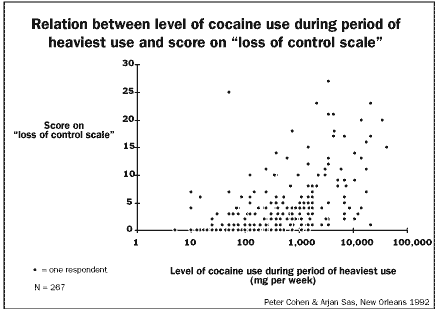
In this graphic you can see how loss of control scores are divided for the period of maximum use in a respondent's career, and at the same time you can see how they are divided against amount of mg used per week during peak use period.
Very clearly the great bulk of our experienced users have a score between 0 and ten. Second, a score between 0 and ten occurs between level of 10 mg per week to ten grams per week. This range is phenomenal! Scores surpassing ten occur between 10 mg and 20 grams per week, an enormous range as well.
The strangest phenomenon of all is that 34% of all respondents have a score of zero on this scale. In spite of the range of use that still allows for low scores, statistically it is clear that score on our scale increases when level of use increases. This is conform our expectations.
We can see that amount of use relates to score on this scale (Pearsons R is 0.49 (a < 0.01). This datum runs counter to other findings we did in our cocaine studies, that is that scores on properly made "effect of cocaine scales" have a very small relation to amount of use[5]. But, let us assume on the basis of a Pearson R of 0.49 that amount of use is one of the systematic determinants of loss of control ( as measured in our list of items). In that case it is relevant to look at the prevalence of different levels of use during careers of our respondents. First we will show you level of use through time for all 268 respondents we interviewed.
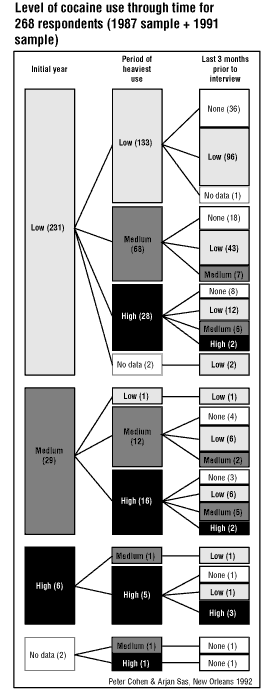
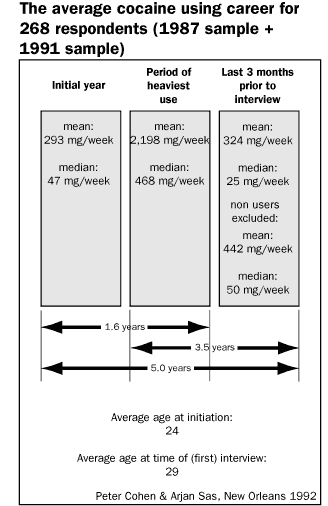
As you can see most respondents never use more than at a low level, but about 25% has a so called top period in which their use level is defined as high. But such a level of use is almost never maintained. In time, very many experienced users develop to a zero level of use.
We have data for 64 cocaine users, taken from the group of 160 we interviewed first in 1987. We followed these users up in 1991 and traced their adventures with cocaine between we first saw them and the four years since. Here the phenomenon of developing towards abstinence is even more visible. Almost 63% of all respondents have not used any cocaine during the three months preceding the interview.
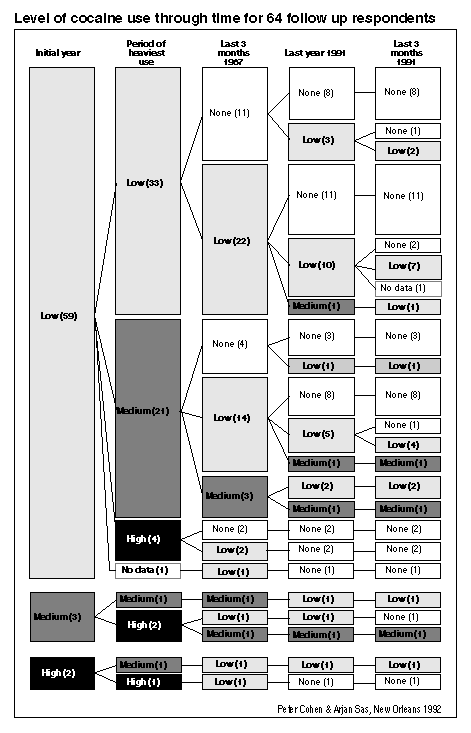
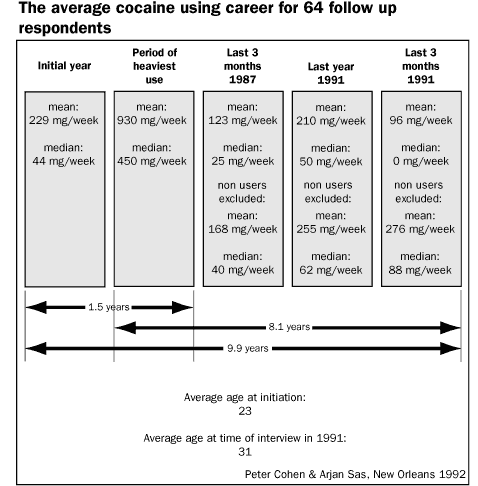
Let us combine the data of our loss of control scale and the development data of level of use over time.
First, most respondents score nil to low on the loss of control scale.
The scores on the scale show some relation to levels of use (as measured
during top period in a career). A high level of use increases probability
of a higher score on the "loss of control scale". But, high
levels of use (if at all) are for most users just a limited period in
time.
For all 268 respondents we computed, that average top period length is
about 12 months (median 8 months). If we look only at those who during
top level period used at a high level we see their top period averages
19 months (median 12 months), and those who used at medium level averages
18 months (median 12 months).
Conclusion
Whatever the etiology of loss of control, we may conclude that loss of control as a function of heavy use of cocaine, is a rare phenomenon
- if we measure it as score on the loss of control scale;
- if we measure it as maintenance of high levels of use over time.
Caution
It goes without saying that our approach to loss of control is a post hoc undertaking. The research project presented here was not designed to measure loss of control. It does not allow conclusions in relation to loss of control definitions that depart from other items than described here, e.g. diagnostic tools as given in DSM protocols. Moreover, the theoretical fundaments of the loss of control concept are loose, not to say shaky.
References
Michael M. Bozarth (1990), Drug addiction as a psychobiological process. In: David M. Warburton (ed): Addiction Controversies. London: Harwood Academic Press.
Dan Waldorf, et al (1991), Cocaine changes. The experience of using and quitting. Philadelphia: Temple University Press.
Norman E. Zinberg (1984), Drug, set and setting. The basis for controlled intoxicant use. New Haven: Yale Univetrsity Press.
Peter D.A.Cohen (1989), Cocaine use in Amsterdam in non-deviant subcultures. Amsterdam: University of Amsterdam.
Notes
- Although I do not exclude that for some forms of "addiction" this explanational model may be useful. The problem is here in choosing one's definition of addiction. Much behaviour which is diagnosed as addiction will not be governed by neurobiological processes.
- Patricia Cohen, Jacob Cohen: "The Clinicians Illusion" Arch Gen Psychiatry 1984; 41 (1178-1182).
- A slightly better defintion would of course be: conventional for the sub culture a particular drug user is part of. But also this definition does not account for changes in rule/culture systems that particular persons may pursue. Break with a "conventional" system to drift into another one, will probably be seen by those who are left behind as "loss of control".
- Final report of follow up investigation and of cocaine use with 108 'new users' of 1991 is in progress. All cocaine use investigations mentioned here were funded by the Dutch Ministry of Health, Welfare and Cultural Affairs.
- Cohen, Peter D.A.: Cocaine use in Amsterdam. University of Amsterdam 1989.
